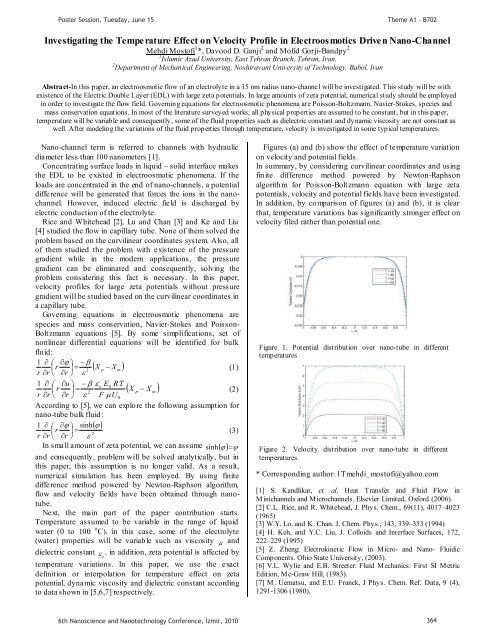Photonic crystals in biology
Photonic crystals in biology
Photonic crystals in biology
You also want an ePaper? Increase the reach of your titles
YUMPU automatically turns print PDFs into web optimized ePapers that Google loves.
Poster Session, Tuesday, June 15<br />
Theme A1 - B702<br />
Investigat<strong>in</strong>g the Temperature Effect on Velocity Profile <strong>in</strong> Electroosmotics Driven Nano-Channel<br />
Mehdi Mostofi 1 *, Davood D. Ganji 2 and Mofid Gorji-Bandpy 2<br />
1 Islamic Azad University, East Tehran Branch, Tehran, Iran.<br />
2 Department of Mechanical Eng<strong>in</strong>eer<strong>in</strong>g, Noshiravani University of Technology, Babol, Iran<br />
Abstract-In this paper, an electroosmotic flow of an electrolyte <strong>in</strong> a 15 nm radius nano-channe l will be <strong>in</strong>vestigated. This study will be with<br />
existence of the Electric Double Layer (EDL) with large zeta potentials. In large amounts of zeta potential, numerical study should be employed<br />
<strong>in</strong> order to <strong>in</strong>vestigate the flow field. Govern<strong>in</strong>g equations for electroosmotic phenomena are Poisson-Boltzmann, Navier-Stokes, species and<br />
mass conservation equations. In most of the literature surveyed works, all physical properties are assumed to be constant, but <strong>in</strong> this paper,<br />
temperature will be variable and consequently, some of the fluid properties such as dielectric constant and dynamic viscosity are not constant as<br />
well. After model<strong>in</strong>g the variations of the fluid properties through temperature, velocity is <strong>in</strong>vestigated <strong>in</strong> some typical temperatures.<br />
Nano-channel term is referred to channels with hydraulic<br />
diameter less than 100 nanometers [1].<br />
Concentrat<strong>in</strong>g surface loads <strong>in</strong> liquid – solid <strong>in</strong>terface makes<br />
the EDL to be existed <strong>in</strong> electroosmotic phenomena. If the<br />
loads are concentrated <strong>in</strong> the end of nano-channels, a potential<br />
difference will be generated that forces the ions <strong>in</strong> the nanochannel.<br />
However, <strong>in</strong>duced electric field is discharged by<br />
electric conduction of the electrolyte.<br />
Rice and Whitehead [2], Lu and Chan [3] and Ke and Liu<br />
[4] studied the flow <strong>in</strong> capillary tube. None of them solved the<br />
problem based on the curvil<strong>in</strong>ear coord<strong>in</strong>ates system. Also, all<br />
of them studied the problem with existence of the pressure<br />
gradient while <strong>in</strong> the modern applications, the pressure<br />
gradient can be elim<strong>in</strong>ated and consequently, solv<strong>in</strong>g the<br />
problem consider<strong>in</strong>g this fact is necessary. In this paper,<br />
velocity profiles for large zeta potentials without pressure<br />
gradient will be studied based on the curvil<strong>in</strong>ear coord<strong>in</strong>ates <strong>in</strong><br />
a capillary tube.<br />
Govern<strong>in</strong>g equations <strong>in</strong> electroosmotic phenomena are<br />
species and mass conservation, Navier-Stokes and Poisson-<br />
Boltzmann equations [5]. By some simplifications, set of<br />
nonl<strong>in</strong>ear differential equations will be identified for bulk<br />
flu id:<br />
1 <br />
<br />
r<br />
X p<br />
X m<br />
<br />
2<br />
(1)<br />
r r<br />
r<br />
<br />
1 u<br />
<br />
e<br />
E0<br />
RT<br />
r<br />
<br />
X<br />
p<br />
X<br />
m<br />
<br />
2<br />
(2)<br />
r r<br />
r<br />
F U<br />
0<br />
Accord<strong>in</strong>g to [5], we can explore the follow<strong>in</strong>g assumption for<br />
nano-tube bulk fluid:<br />
1 <br />
s<strong>in</strong>h<br />
<br />
<br />
r<br />
<br />
2<br />
(3)<br />
r r<br />
r<br />
<br />
In small amount of zeta potential, we can assume s<strong>in</strong>h <br />
and consequently, problem will be solved analytically, but <strong>in</strong><br />
this paper, this assumption is no longer valid. As a result,<br />
numerical simulation has been employed. By us<strong>in</strong>g f<strong>in</strong>ite<br />
difference method powered by Newton-Raphson algorithm,<br />
flow and velocity fields have been obta<strong>in</strong>ed through nanotube.<br />
Next, the ma<strong>in</strong> part of the paper contribution starts.<br />
Temperature assumed to be variable <strong>in</strong> the range of liquid<br />
water (0 to 100 o C). <strong>in</strong> this case, some of the electrolyte<br />
(water) properties will be variable such as viscosity and<br />
dielectric constant . <strong>in</strong> addition, zeta potential is affected by<br />
e<br />
temperature variations. In this paper, we use the exact<br />
def<strong>in</strong>ition or <strong>in</strong>terpolation for temperature effect on zeta<br />
potential, dynamic viscosity and dielectric constant accord<strong>in</strong>g<br />
to data shown <strong>in</strong> [5,6,7] respectively.<br />
Figures (a) and (b) show the effect of temperature variation<br />
on velocity and potential fields.<br />
In summary, by consider<strong>in</strong>g curvil<strong>in</strong>ear coord<strong>in</strong>ates and us<strong>in</strong>g<br />
f<strong>in</strong>ite difference method powered by Newton-Raphson<br />
algorithm for Poisson-Boltzmann equation with large zeta<br />
potentials, velocity and potential fields have been <strong>in</strong>vestigated.<br />
In addition, by comparison of figures (a) and (b), it is clear<br />
that, temperature variations has significantly stronger effect on<br />
velocity filed rather than potential one.<br />
Figure 1. Potential distribution over nano-tube <strong>in</strong> different<br />
temperatures<br />
Figure 2. Velocity distribution over nano-tube <strong>in</strong> different<br />
temperatures.<br />
* Correspond<strong>in</strong>g author: 1Tmehdi_mostofi@yahoo.com<br />
[1] S. Kandlikar, et. al, Heat Transfer and Fluid Flow <strong>in</strong><br />
M<strong>in</strong>ichannels and Microchannels. Elsevier Limited, Oxford (2006).<br />
[2] C.L. Rice, and R. Whitehead, J. Phys. Chem., 69(11), 4017–4023<br />
(1965)<br />
[3] W.Y. Lo, and K. Chan. J. Chem. Phys., 143, 339–353 (1994)<br />
[4] H. Keh, and Y.C. Liu, J. Colloids and Interface Surfaces, 172,<br />
222–229 (1995)<br />
[5] Z. Zheng: Electrok<strong>in</strong>etic Flow <strong>in</strong> Micro- and Nano- Fluidic<br />
Components. Ohio State University, (2003).<br />
[6] V.L. Wylie and E.B. Streeter: Fluid Mechanics: First SI Metric<br />
Edition, Mc-Graw Hill, (1983).<br />
[7] M. Uematsu, and E.U. Franck, J Phys. Chem. Ref. Data, 9 (4),<br />
1291-1306 (1980).<br />
6th Nanoscience and Nanotechnology Conference, zmir, 2010 364













